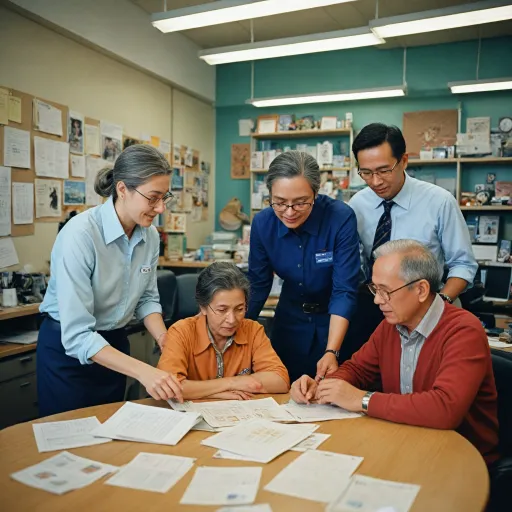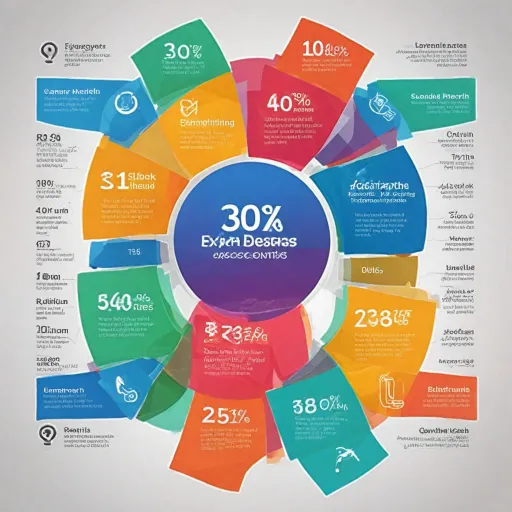
Understanding decision making in hierarchical organizations
How decisions flow in layered organizations
In any hierarchical organization, decision making is often compared to solving a crossword puzzle. Each clue represents a challenge or a question, and the answer must fit within the structure, just like decisions must align with the organization's layers and authority. The top authority typically sets the tone, while communication flows down through several layers, each adding its own perspective before a final answer is reached. This process can be slow and complex, especially when making decisions that impact multiple departments or teams.
Hierarchical organizations rely on clear processes to ensure every decision is made with the right input and oversight. However, these processes can sometimes resemble the NYT mini crossword—quick in theory, but tricky in practice when clues are ambiguous or when answers require collaboration across layers. The challenge is not just about finding the right answer, but also about ensuring that the answer like a solution in a crossword fits with the rest of the organizational structure.
- Authority: The top layer holds the main decision-making power, but must delegate effectively to avoid bottlenecks.
- Communication: Information must travel up and down the hierarchy, often leading to delays or misinterpretations.
- Processes: Multiple layers mean more steps, which can slow down response times and make it harder to adapt quickly.
Just as crossword answers must fit the given number of letters, decisions in a hierarchical organization must fit within established policies and culture. This can make innovation and rapid development challenging, as each layer may interpret clues differently. The complexity increases when considering the need for fairness and transparency, which are explored further in later sections.
For organizations looking to improve their decision making, understanding these dynamics is crucial. Addressing these challenges is not just about efficiency, but also about ensuring that every clue—every piece of information—leads to the best possible answer for the organization as a whole. For more on how diversity, equity, inclusion, and accessibility training can support better decision making in HR, explore this resource on enhancing HR with AI and DEIA training.
The role of artificial intelligence in streamlining processes
AI as a Catalyst for Efficient Workflows
In a hierarchical organization, decision making often resembles a complex crossword puzzle. Each layer, like a clue, must be solved before moving to the next. This structure can slow down processes, as decisions require approval from multiple levels of authority. Artificial intelligence is changing this dynamic by automating repetitive tasks and providing real-time data analysis. The result is faster communication between layers and more informed decisions at every level.
AI tools can process vast amounts of information, acting like a crossword answer key for HR professionals. Instead of waiting for manual reports or top-down directives, managers receive actionable insights instantly. This helps organizations streamline their decision making processes, reducing bottlenecks and improving overall efficiency. For example, AI-driven analytics can highlight patterns in employee development or flag potential issues before they escalate, supporting proactive management in hierarchical organizations.
- Automated data collection reduces manual errors and speeds up reporting
- AI-powered dashboards provide clear visualizations, making complex information easier to understand
- Natural language processing tools facilitate smoother communication across authority levels
Just as a crossword clue guides you to the right answer, AI guides HR teams through layers of organizational complexity. This technology not only accelerates decision making but also ensures that every answer, like in a mini crossword, is based on accurate, up-to-date information. For a deeper look at how AI supports fairness and inclusion in these processes, explore this resource on DEIJB in artificial intelligence for human resources.
Enhancing transparency and accountability with AI
Building Trust Through AI-Driven Insights
In a hierarchical organization, decision making often flows from the top authority down through multiple layers. This structure can sometimes obscure how and why certain decisions are made, leaving employees searching for the right clue or answer—much like tackling a crossword in the NYT mini. Artificial intelligence is changing this dynamic by making processes more transparent and accountable.
- Traceable Decisions: AI systems can log every step in the decision making process, providing a clear audit trail. This is especially valuable in organizations with complex layers, where communication can get lost or misinterpreted.
- Consistent Application: Algorithms apply rules uniformly, reducing the risk of subjective interpretation by different managers at various levels. Employees can see the logic behind decisions, similar to finding the right crossword answer after following each clue.
- Real-Time Feedback: AI tools can offer instant feedback on why a particular decision was made, helping staff understand the reasoning—almost like revealing the nyt crossword solution after a tough puzzle.
Transparency is not just about open communication; it’s about making the logic behind hierarchical decision making accessible to everyone. This shift helps organizations move away from the traditional top-down approach, where only a select few hold the answers. Instead, AI enables a culture where information flows more freely, supporting development and trust at every level.
For organizations looking to enhance managerial staffing and accountability, leveraging AI can be a game changer. For more on this, see enhancing managerial staffing with artificial intelligence.
Ultimately, integrating AI into hierarchical decision making processes is like solving a mini crossword—each clue and answer brings more clarity, helping organizations build a transparent and accountable environment.
Addressing bias and fairness in AI-driven HR decisions
Unpacking Bias in Automated Decision Making
In hierarchical organizations, the introduction of artificial intelligence into decision making processes brings both opportunities and risks. One of the most pressing concerns is the potential for bias and fairness issues in AI-driven HR decisions. While AI can process vast amounts of data and provide answers like a crossword clue solver, it can also inherit or even amplify existing biases present in historical data or organizational structures.
- Bias in Data: AI systems learn from past decisions, which may reflect the preferences or blind spots of top authority figures. This can lead to unfair outcomes, especially in organizations with multiple layers of decision making.
- Opaque Algorithms: Sometimes, the logic behind an AI's answer is as hard to decipher as a tricky mini crossword clue. Without transparency, it becomes difficult to challenge or understand why certain decisions were made, especially when communication flows through many layers.
- Reinforcing Hierarchies: In a hierarchical organization, AI can unintentionally reinforce existing power dynamics. For example, if the system is trained on decisions made by upper management, it may favor similar patterns, making it harder for new perspectives to emerge.
Ensuring Fairness in AI-Driven HR Decisions
To address these challenges, organizations need to focus on fairness and accountability in their AI systems. This involves regular audits of AI decision making processes, much like checking crossword answers for accuracy. It also means involving diverse teams in the development and review of AI tools, ensuring that different layers of the organization have a voice in how these systems are built and used.
Clear communication about how AI makes decisions is essential. Employees should know how their data is used and have the opportunity to challenge decisions that seem unfair. Just as in word games, where every letter counts, every step in the AI process should be open to scrutiny to build trust and credibility.
Ultimately, the goal is to create AI systems that support fair, transparent, and equitable decision making in hierarchical organizations. By addressing bias and promoting accountability, organizations can ensure that AI becomes a tool for positive development rather than a source of new challenges.
Challenges of integrating AI into hierarchical structures
Barriers to Seamless AI Adoption in Multi-Layered Organizations
Integrating artificial intelligence into hierarchical organizations is not as straightforward as solving a crossword clue. The process involves navigating multiple layers of authority, communication, and decision making. These layers, much like the answers in a mini crossword, can create bottlenecks and slow down the adoption of new technologies. In hierarchical organizations, top-down decision making often means that AI initiatives require approval from several levels of management, which can delay implementation and reduce agility.
Complexity of Communication and Change Management
Communication is another significant challenge. When introducing AI-driven processes, clear and consistent messaging is crucial. However, in organizations with many layers, messages can become distorted as they move from the top authority to frontline teams. This can lead to confusion about the purpose and benefits of AI, making it harder to gain buy-in from all stakeholders. Just like finding the right crossword answer, aligning everyone on the same page requires effort and clarity.
Legacy Systems and Resistance to Change
Many hierarchical organizations rely on established processes and legacy systems. Integrating AI into these existing structures can be challenging. Employees may feel uncertain about how AI will impact their roles, leading to resistance. The development of AI solutions must consider these concerns, ensuring that the transition is smooth and that employees understand how AI supports, rather than replaces, their decision making responsibilities.
Maintaining Consistency Across Layers
Ensuring that AI-driven decisions are consistent across all layers of the organization is another hurdle. In a crossword, each letter must fit perfectly for the answer to make sense. Similarly, AI systems must be calibrated to deliver reliable results, regardless of where in the hierarchy they are applied. This requires ongoing monitoring, training, and adjustment to ensure that the technology supports fair and effective decision making throughout the organization.
- Multiple layers can slow down AI adoption
- Communication gaps may hinder understanding of AI benefits
- Legacy systems and resistance to change are common obstacles
- Consistency in AI-driven decisions is essential for credibility
Organizations that address these challenges are better positioned to unlock the full potential of AI in their decision making processes. Like solving a crossword puzzle, success depends on finding the right answers and ensuring every piece fits together across the organization.
Best practices for leveraging AI in HR decision making
Building a Foundation for Responsible AI Use
Implementing artificial intelligence in hierarchical organizations requires more than just technology adoption. It’s about creating a framework that supports responsible, transparent, and effective decision making. Here are some best practices to guide organizations as they integrate AI into their HR processes:
- Clarify Decision Authority: Define who holds the top authority for AI-driven decisions. In layered organizations, clarity on decision rights prevents confusion and ensures accountability. This is like finding the right crossword answer to a complex clue—every letter matters for the whole solution.
- Promote Open Communication: Encourage transparent communication across all layers. When introducing AI, make sure everyone understands how decisions are made, what data is used, and how outcomes are determined. This helps demystify the "organization crossword" of decision making and builds trust.
- Continuous Development and Training: Invest in ongoing development for HR teams and leaders. Understanding AI’s capabilities and limitations is crucial for making hierarchical decisions that are fair and effective. Training should address both technical skills and ethical considerations, much like preparing for a challenging NYT mini crossword.
- Monitor for Bias and Fairness: Regularly review AI-driven processes to identify and address potential bias. Use diverse datasets and involve cross-functional teams in evaluating outcomes. This approach helps ensure that the "clue answer" to fairness is always top of mind.
- Document Processes and Decisions: Keep detailed records of how AI systems make decisions, including the logic behind recommendations. Documentation supports transparency and provides a clear "crossword clue" for future audits or reviews.
- Iterate and Improve: Treat AI integration as an ongoing process. Gather feedback from all organizational layers, analyze outcomes, and refine systems regularly. Like solving a mini crossword, each attempt brings new insights and better answers.
Practical Steps for Effective AI Integration
| Step | Purpose | Example |
|---|---|---|
| Establish clear guidelines | Set boundaries for AI use in decision making | Define which HR decisions AI can support, like candidate screening |
| Engage stakeholders | Ensure buy-in from all layers of the organization | Host workshops to discuss AI’s role in hierarchical decision processes |
| Audit regularly | Maintain fairness and compliance | Schedule periodic reviews of AI-driven outcomes, similar to checking crossword answers for accuracy |
| Foster a culture of learning | Encourage adaptation and growth | Share lessons learned from AI projects across departments |
By following these best practices, hierarchical organizations can make the most of AI’s potential in HR decision making. The process is much like solving a challenging crossword: it requires patience, collaboration, and a willingness to learn from each clue and answer along the way.












